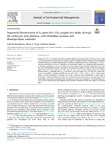Sequential bioconversion of C1-gases (CO, CO2, syngas) into lipids, through the carboxylic acid platform, with Clostridium aceticum and Rhodosporidium toruloides

Use this link to cite
http://hdl.handle.net/2183/38510
Except where otherwise noted, this item's license is described as CC BY-NC-ND 4.0 Attribution-NonCommercial-NoDerivatives 4.0 International
Collections
- Investigación (FCIE) [1243]
Metadata
Show full item recordTitle
Sequential bioconversion of C1-gases (CO, CO2, syngas) into lipids, through the carboxylic acid platform, with Clostridium aceticum and Rhodosporidium toruloidesDate
2023Citation
Robles-Iglesias, R., Veiga, M. C., & Kennes, C. (2023). Sequential bioconversion of C1-gases (CO, CO2, syngas) into lipids, through the carboxylic acid platform, with Clostridium aceticum and Rhodosporidium toruloides. Journal of Environmental Management, 347. https://doi.org/10.1016/J.JENVMAN.2023.119097
Abstract
[Abstract] Syngas (CO, CO2, H2) was effectively bioconverted into lipids in a two-stage process. In the first stage, C1-gases were bioconverted into acetic acid by the acetogenic species Clostridium aceticum through the Wood-Ljungdahl metabolic pathway in a stirred tank bioreactor, reaching a maximum acetic acid concentration of 11.5 g/L, with a production rate of 0.05 g/L·h. Throughout this experiment, samples were extracted at different periods, i.e., different concentrations, to be used in the second stage, aiming at the production of lipids from acetic acid. The yeast Rhodosporidium toruloides, inoculated in the acetogenic medium, was able to efficiently accumulate lipids from acetic acid generated in the first stage. The best results, in terms of lipid content, dry biomass, biomass yield (Y(X/S)) and lipid yield (Y(L/S)) were 39.5% g/g dry cell weight, 3 g/L, 0.35 and 0.107, respectively. In terms of abundance, the lipid profile followed the order: C18:1 > C16:0 > C18:2 > C18:0 > Others. Experiments were also performed to determine the toxicity exerted by high concentrations of acetic acid on R. toruloides, resulting in inhibition at initial acid concentrations around 18 g/L leading to a higher lag phase and being lethal to the yeast at initial acetic acid concentrations around 22 g/L and above. This research paves the way for a novel method of growing oleaginous yeasts to produce sustainable biofuels from syngas or C1-pollutant gases.
Keywords
Acetogenesis
Fatty acid methyl ester
Oleaginous yeast
Biodiesel
Greenhouse gases
Fatty acid methyl ester
Oleaginous yeast
Biodiesel
Greenhouse gases
Description
Financiado para publicación en acceso aberto: Universidade da Coruña/CISUG
Editor version
Rights
CC BY-NC-ND 4.0 Attribution-NonCommercial-NoDerivatives 4.0 International






